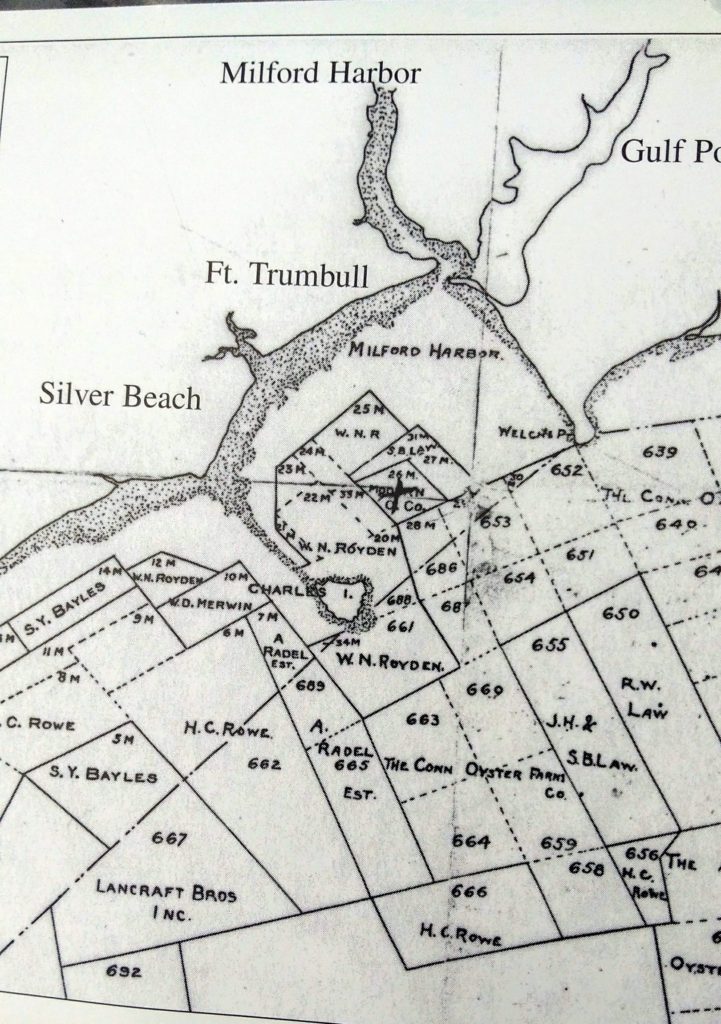By Marilyn May
Milford History

This map shows the divisions of the land under Long Island Sound near Milford for various oystering operations.
When you look at the shell of a just-harvested oyster, it’s probably the ugliest of all shellfish. But inside there is pure joy for connoisseurs of fine foods. It takes years and a lot of work to get that delicacy to your table.
Lucky for us, 30,000 oysters will top the menu at the Milford Oyster Festival on Saturday, Aug. 21 from 10 a.m. to 6 p.m.
Since the festival began in 1975, some people have asked “Why feature oysters?” The answer is that in the mid-1850s oyster farming was growing into a major industry in Milford. By 1888, there were one thousand acres of the Sound floor being farmed and yielding about one million bushels of oysters a year. Oyster farming is part of the heritage of Milford.
It’s been said that during World War II when men were away in the military, almost every boy in town, some as young as 14, worked on the oyster boats or at the dock at one time or another. Lifetime Milford resident Lloyd Jacobs remembers the day Capt. Fred Beloin asked him to come aboard for the day. You can imagine how quickly he said yes. Jacobs lived next door to Beloin, who piloted the The General, and was friendly with Capt. Emil Usinger on the Milford.
Jacobs remembered that the seven-boat oyster fleet left the dock at 4 a.m. and didn’t tie up again until 4 p.m. On this particular trip, however, the captain decided he could get a better price for the day’s haul in Greenport, Long Island, even after calculating the extra fuel costs. That jaunt added hours to a long day.
Anyone lucky enough in the 1950s to have seen the oyster fleet coming up the channel in the afternoon light heading for the harbor saw a magnificent sight that will not be seen again. The seven big, white powerful boats steamed in at a steady clip, all falling into line, always in the same order. People on Gulf Beach would stop and watch. Seeing the fleet enter the harbor was mesmerizing as the boats made easy turns in perfect timing and settled along the dock, ready to go out the next morning.
One day when Usinger wasn’t at the wheel of his boat, he went to a bluff at Fort Trumbull to watch the fleet come in. He, himself, was awed and called it a “breathtakingly beautiful sight.”
Old photos of the oyster docks, once at the end of Dock Road off Gulf Street, show an enormous pile of empty shells called “clutch” waiting for workers to shovel them back into a boat, take them out to an oyster field and pitch them overboard. It could take the crew more than two hours to clear the decks using large – and heavy – oyster shovels.
Each captain had to work in a specific area of the Sound. It’s the same today. If you could see the bottom of the Sound, the underwater land is divided into plots and reminds one of the individual agricultural fields as seen from an airplane.
For land lubbers and oyster lovers, here are a few things to know about this protein-rich marine bivalve that has been harvested for thousands of years in many parts of the world.
First, an oyster lives a pretty exotic life. It begins as a male but has a female phase almost every year; half the year it’s male and half the year it’s female.
They broadcast spawn starting in late June, and the larvae, or fertilized eggs, can swim up to as long as 10 to 14 days. Then if the water temperature and salinity is just right, one out of one million eggs from one oyster permanently attaches to an old shell. The newest crop of shellfish lives on the old shells of a previous season. (Some larvae, however, can attach to rocks.)
It was in the 1800s when Milford mariners mastered the practice of laying down clutch to encourage cultivation of oysters. Once attached, the oyster is called “spat.”
In some locations, as generation after generation of spat grow into adult oysters, they form dense clusters known as oyster reefs.
The oysters’ journey to adulthood, however, is not that easy. Besides humans, the oyster’s greatest predator is a starfish. But oysters are not entirely defenseless. They have dozens of eyes along the inside rim of their shells that enable them to see predators approaching so they can “clam up” when threatened. Otherwise, when the oyster shell is partly open filtering gallons of water and feeding on algae and plankton, a starfish can work its way into the open bivalve and eat it from the inside. Starfish can eat as many as seven a day.
There’s a very common question about oysters: Is it still alive when I eat it? Yes. If you eat a raw oyster, it must be alive or else it is not safe to eat. But the oyster likely feels no pain – it has no central nervous system. So slurp away and savor the salty, briny taste.
Marilyn May is a lifelong resident of Milford and is on the board of the Milford Historical Society.